GARRICK, J.A.F. 1957
Studies on New Zealand Elasmobranchii. Part VI. Two new species of Etmopterus from New Zealand.
Bulletin of the Museum of Comparative Zoology at Harvard College, 116 (3): 169-190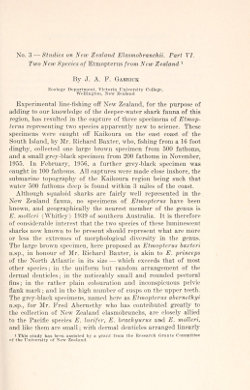 No. 3 - Studies on New Zealand Elasmobranchii. Part VI.
No. 3 - Studies on New Zealand Elasmobranchii. Part VI.
Two New Species of Etmopterus from New Zealand 1
By J. A. F. GARRICK
Zoology Department, Victoria University College,
Wellington, New Zealand
Experimental line-fishing off New Zealand, for the purpose of
adding to our knowledge of the deeper-water shark fauna of this
region, has resulted in the capture of three specimens of Etmop-
terus representing two species apparently new to science. These
specimens were caught off Kaikoura on the east coast of the
South Island, by Mr. Richard Baxter, who, fishing from a 16 foot
dinghy, collected one large brown specimen from 500 fathoms,
and a small grey-black specimen from 200 fathoms in November,
1955. In February, 1956, a further grey-black specimen was
caught in 100 fathoms. All captures were made close inshore, the
submarine topography of the Kaikoura region being such that
water 500 fathoms deep is found within 3 miles of the coast.
Although squaloid sharks are fairly well represented in the
New Zealand fauna, no specimens of Etmopterus have been
known, and geographically the nearest member of the genus is
E. molleri (Whitley) 1939 of southern Australia. It is therefore
of considerable interest that the two species of these luminescent
sharks now known to be present should represent what are more
or less the extremes of morphological diversity in the genus.
The large brown specimen, here proposed as Etmopterus baxteri
n.sp., in honour of Mr. Richard Baxter, is akin to E. princeps
of the North Atlantic in its size - which exceeds that of most
other species; in the uniform but random arrangement of the
dermal denticles; in the noticeably small and rounded pectoral
fins; in the rather plain colouration and inconspicuous pelvic
flank mark; and in the high number of cusps on the upper teeth.
The grey-black specimens, named here as Etmopterus abernethyi
n.sp., for Mr. Fred Abernethy who has contributed greatly to
the collection of New Zealand elasmobranchs, are closely allied
to the Pacific species E. lucifer, E. brachyurus and E. molleri,
and like them are small; with dermal denticles arranged linearly
____________________________________________________
1 This study has been assisted by a grant from the Research Grants Committee
of the Universitv of New Zealand.
page 172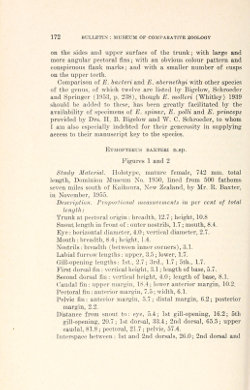 on the sides and upper surface of the trunk; with large and
on the sides and upper surface of the trunk; with large and
more angular pectoral fins; with an obvious colour pattern and
conspicuous flank marks; and with a smaller number of cusps
on the upper teeth.
Comparison of E. baxteri and E. abernethyi with other species
of the genus, of which twelve are listed by Bigelow, Schroeder
and Springer (1953, p. 238), though E. molleri (Whitley) 1939
should be added to these, has been greatly facilitated by the
availability of specimens of E. spinax, E. polli and E. princeps
provided by Drs. H. B. Bigelow and W. C. Schroeder, to whom
I am also especially indebted for their generosity in supplying
access to their manuscript key to the species.
ETMOPTERUS BAXTERI n.sp.
Figures 1 and 2
Study Material. Holotype, mature female, 742 mm. total
length, Dominion Museum No. 1950, lined from 500 fathoms
seven miles south of Kaikoura, New Zealand, by Mr. R. Baxter,
in November, 1955.
Description. Proportional measurements in per cent of total
length:
Trunk at pectoral origin: breadth, 12.7; height, 10.8
Snout length in front of: outer nostrils, 1.7; mouth, 8.4.
Eye: horizontal diameter, 4.0; vertical diameter, 2.7.
Mouth: breadth, 8.4; height, 1.4.
Nostrils: breadth (between inner corners), 3.1.
Labial furrow lengths: upper, 3.5; lower, 1.7.
Gill-opening lengths: 1st., 2.7; 3rd., 1.7; 5th., 1.7.
First dorsal fin: vertical height, 3.1; length of base, 5.7.
Second dorsal fin: vertical height, 4.0; length of base, 8.1.
Caudal fin: upper margin, 18.4; lower anterior margin, 10.2.
Pectoral fin: anterior margin, 7.5; width, 6.1.
Pelvic fin: anterior margin, 5.7; distal margin, 6.2; posterior
margin, 2.2.
Distance from snout to: eye, 5.4; 1st gill-opening, 16.2; 5th
gill-opening, 20.7; 1st dorsal, 33.4; 2nd dorsal, 65.5; upper
caudal, 81.8; pectoral, 21.7; pelvic, 57.4.
Interspace between: 1st and 2nd dorsals, 26.0; 2nd dorsal and
page 173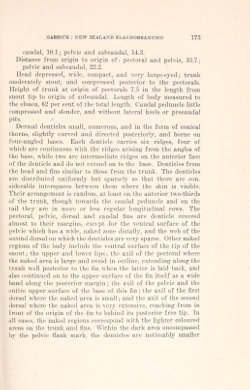 caudal, 10.1; pelvic and subcaudal, 14.3.
caudal, 10.1; pelvic and subcaudal, 14.3.
Distance from origin to origin of: pectoral and pelvic, 35.7;
pelvic and subcaudal, 22.2.
Head depressed, wide, compact, and very large-eyed; trunk
moderately stout, and compressed posterior to the pectorals.
Height of trunk at origin of pectorals 7.5 in the length from
snout tip to origin of subcaudal. Length of body measured to
the cloaca, 62 per cent of the total length. Caudal peduncle little
compressed and slender, and without lateral keels or precaudal
pits.
Dermal denticles small, numerous, and in the form of conical
thorns, slightly curved and directed posteriorly, and borne on
four-angled bases. Each denticle carries six ridges, four of
which are continuous with the ridges arising from the angles of
the base, while two are intermediate ridges on the anterior face
of the denticle and do not extend on to the base. Denticles from
the head and fins similar to those from the trunk. The denticles
are distributed uniformly but sparsely so that there are con-
siderable interspaces between them where the skin is visible.
Their arrangement is random, at least on the anterior two-thirds
of the trunk, though towards the caudal peduncle and on the
tail they are in more or less regular longitudinal rows. The
pectoral, pelvic, dorsal and caudal fins are denticle covered
almost to their margins, except for the ventral surface of the
pelvic which has a wide, naked zone distally, and the web of the
second dorsal on which the denticles are very sparse. Other naked
regions of the body include the ventral surface of the tip of the
snout; the upper and lower lips; the axil of the pectoral where
the naked area is large and ovoid in outline, extending along the
trunk well posterior to the fin when the latter is laid back, and
also continued on to the upper surface of the fin itself as a wide
band along the posterior margin; the axil of the pelvic and the
entire upper surface of the base of this fin; the axil of the first
dorsal where the naked area is small; and the axil of the second
dorsal where the naked area is very extensive, reaching from in
front of the origin of the fin to behind its posterior free tip. In
all cases, the naked regions correspond with the lighter coloured
areas on the trunk and fins. Within the dark area encompassed
by the pelvic flank mark, the denticles are noticeably smaller
page 174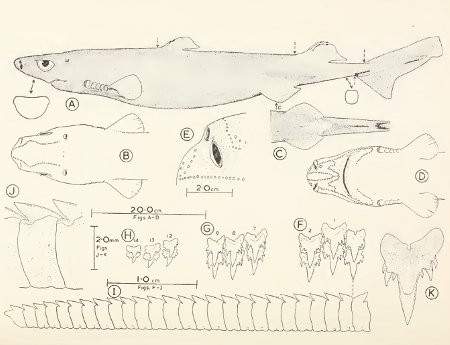
Figure 1. Etmopterus baxteri n.sp., holotype, 742 mm. total length. A,
lateral view and insets of sections through snout and peduncle; B, dorsal
view of head showing prominent lateral line pores; C, ventral view of
peduncle; B, ventral view of head with pores as in B; E, left nostril;
F-E, upper teeth from right side, row numbers indicated above; I, lower
teeth, right side; J, 10th lower tooth, right side; K, 6th upper tooth, right
side, (c = level of cloaca.)
page 175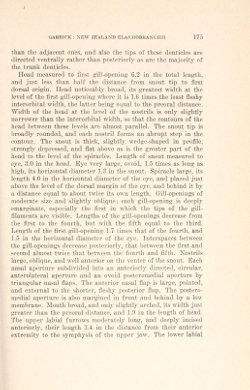 than the adjacent ones, and also the tips of these denticles are
than the adjacent ones, and also the tips of these denticles are
directed ventrally rather than posteriorly as are the majority of
the trunk denticles.
Head measured to first gill-opening 6.2 in the total length,
and just less than half the distance from snout tip to first
dorsal origin. Head noticeably broad, its greatest width at the
level of the first gill-opening where it is 1.6 times the least fleshy
interorbital width, the latter being equal to the preoral distance.
Width of the head at the level of the nostrils is only slightly
narrower than the interorbital width, so that the contours of the
head between these levels are almost parallel. The snout tip is
broadly rounded, and each nostril forms an abrupt step in the
contour. The snout is thick, slightly wedge-shaped in profile,
strongly depressed, and flat above as is the greater part of the
head to the level of the spiracles. Length of snout measured to
eye, 3.0 in the head. Eye very large, ovoid, 1.5 times as long as
high, its horizontal diameter 1.3 in the snout. Spiracle large, its
length 4.0 in the horizontal diameter of the eye, and placed just
above the level of the dorsal margin of the eye, and behind it by
a distance equal to about twice its own length. Gill-openings of
moderate size and slightly oblique; each gill-opening is deeply
emarginate, especially the first in which the tips of the gill-
filaments are visible. Lengths of the gill-openings decrease from
the first to the fourth, but with the fifth equal to the third.
Length of the first gill-opening 1.7 times that of the fourth, and
1.5 in the horizontal diameter of the eye. Interspaces between
the gill-openings decrease posteriorly, that between the first and
second almost twice that between the fourth and fifth. Nostrils
large, oblique, and well anterior on the venter of the snout. Each
nasal aperture subdivided into an anteriorly directed, circular,
anterolateral aperture and an ovoid posteromedial aperture by
triangular nasal flaps. The anterior nasal flap is large, pointed,
and external to the shorter, fleshy posterior flap. The postero-
medial aperture is also margined in front and behind by a low
membrane. Mouth broad, and only slightly arched, its width just
greater than the preoral distance, and 1.9 in the length of head.
The upper labial furrows moderately long, and deeply incised
anteriorly, their length 1.4 in the distance from their anterior
extremity to the symphysis of the upper jaw. The lower labial
page 176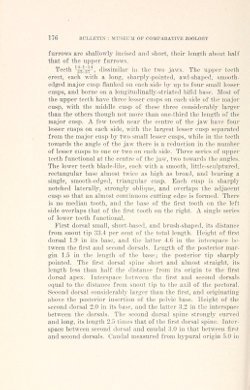 furrows are shallowly incised and short, their length about half
furrows are shallowly incised and short, their length about half
that of the upper furrows.
Teeth 14-1-14/25-27, dissimilar in the two jaws. The upper teeth
erect, each with a long, sharply-pointed, awl-shaped, smooth-
edged major cusp flanked on each side by up to four small lesser
cusps, and borne on a longitudinally-striated bifid base. Most of
the upper teeth have three lesser cusps on each side of the major
cusp, with the middle cusp of these three considerably larger
than the others though not more than one-third the length of the
major cusp. A few teeth near the centre of the jaw have four
lesser cusps on each side, with the largest lesser cusp separated
from the major cusp by two small lesser cusps, while in the teeth
towards the angle of the jaw there is a reduction in the number
of lesser cusps to one or two on each side. Three series of upper
teeth functional at the centre of the jaw, two towards the angles.
The lower teeth blade-like, each with a smooth, little-sculptured,
rectangular base almost twice as high as broad, and bearing a
single, smooth-edged, triangular cusp. Each cusp is sharply
notched laterally, strongly oblique, and overlaps the adjacent
cusp so that an almost continuous cutting edge is formed. There
is no median tooth, and the base of the first tooth on the left
side overlaps that of the first tooth on the right. A single series
of lower teeth functional.
First dorsal small, short-based, and brush-shaped, its distance
from snout tip 33.4 per cent of the total length. Height of first
dorsal 1.9 in its base, and the latter 4.6 in the interspace be-
tween the first and second dorsals. Length of the posterior mar-
gin 1.5 in the length of the base; the posterior tip sharply
pointed. The first dorsal spine short and almost straight, its
length less than half the distance from its origin to the first
dorsal apex. Interspace between the first and second dorsals
equal to the distance from snout tip to the axil of the pectoral.
Second dorsal considerably larger than the first, and originating
above the posterior insertion of the pelvic base. Height of the
second dorsal 2.0 in its base, and the latter 3.2 in the interspace
between the dorsals. The second dorsal spine strongly curved
and long, its length 2.5 times that of the first dorsal spine. Inter-
space between second dorsal and caudal 3.0 in that between first
and second dorsals. Caudal measured from hypural origin 5.0 in
page 177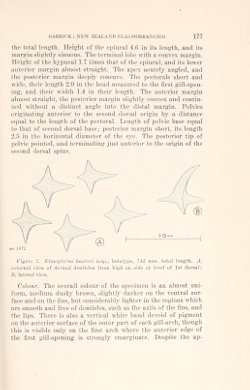 the total length. Height of the epiural 4.6 in its length, and its
the total length. Height of the epiural 4.6 in its length, and its
margin slightly sinuous. The terminal lobe with a convex margin.
Height of the hypural 1.7 times that of the epiural, and its lower
anterior margin almost straight. The apex acutely angled, and
the posterior margin deeply concave. The pectorals short and
wide, their length 2.0 in the head measured to the first gill-open-
ing, and their width 1.4 in their length. The anterior margin
almost straight, the posterior margin slightly convex and contin-
ued without a distinct angle into the distal margin. Pelvics
originating anterior to the second dorsal origin by a distance
equal to the length of the pectoral. Length of pelvic base equal
to that of second dorsal base; posterior margin short, its length
2.5 in the horizontal diameter of the eye. The posterior tip of
pelvic pointed, and terminating just anterior to the origin of the
second dorsal spine.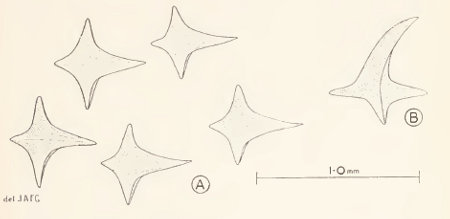
Figure 2. Etmopterus baxteri n.sp., holotype, 742 mm. total length. A,
external view of dermal denticles from high on side at level of 1st dorsal;
B, lateral view.
Colour. The overall colour of the specimen is an almost uni-
form, medium dusky brown, slightly darker on the ventral sur-
face and on the fins, but considerably lighter in the regions which
are smooth and free of denticles, such as the axils of the fins, and
the lips. There is also a vertical white band devoid of pigment
on the anterior surface of the outer part of each gill-arch, though
this is visible only on the first arch where the anterior edge of
the first gill-opening is strongly emarginate. Despite the ap-
page 178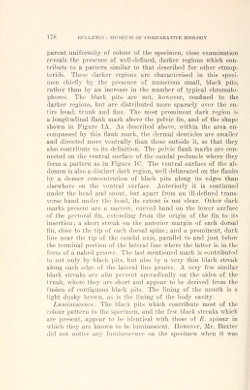 parent uniformity of colour of the specimen, close examination
parent uniformity of colour of the specimen, close examination
reveals the presence of well-defined, darker regions which con-
tribute to a pattern similar to that described for other etmop-
terids. These darker regions are characterised in this speci-
men chiefly by the presence of numerous small, black pits,
rather than by an increase in the number of typical chromato-
phores. The black pits are not, however, confined to the
darker regions, but are distributed more sparsely over the en-
tire head, trunk and fins. The most prominent dark region is
a longitudinal flank mark above the pelvic fin, and of the shape
shown in Figure 1A. As described above, within the area en-
compassed by this flank mark, the dermal denticles are smaller
and directed more ventrally than those outside it, so that they
also contribute to its definition. The pelvic flank marks are con-
nected on the ventral surface of the caudal peduncle where they
form a pattern as in Figure 1C. The ventral surface of the ab-
domen is also a distinct dark region, well delineated on the flanks
by a denser concentration of black pits along its edges than
elsewhere on the ventral surface. Anteriorly it is continued
under the head and snout, but apart from an ill-defined trans-
verse band under the head, its extent is not clear. Other dark
marks present are a narrow, curved band on the lower surface
of the pectoral fin, extending from the origin of the fin to its
insertion; a short streak on the anterior margin of each dorsal
fin, close to the tip of each dorsal spine; and a prominent, dark
line near the tip of the caudal axis, parallel to and just below
the terminal portion of the lateral line where the latter is in the
form of a naked groove. The last-mentioned mark is contributed
to not only by black pits, but also by a very thin black streak
along each edge of the lateral line groove. A very few similar
black streaks are also present sporadically on the sides of the
trunk, where they are short and appear to be derived from the
fusion of contiguous black pits. The lining of the mouth is a
light dusky brown, as is the lining of the body cavity.
Luminescence. The black pits which contribute most of the
colour pattern to the specimen, and the few black streaks which
are present, appear to be identical with those of E. spinax in
which they are known to be luminescent. However, Mr. Baxter
did not notice any luminescence on the specimen when it was
page 179 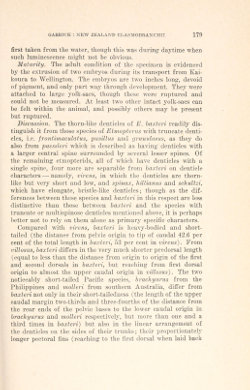 first taken from the water, though this was during daytime when
first taken from the water, though this was during daytime when
such luminescence might not be obvious.
Maturity. The adult condition of the specimen is evidenced
by the extrusion of two embryos during its transport from Kai-
koura to Wellington. The embryos are two inches long, devoid
of pigment, and only part way through development. They were
attached to large yolk-sacs, though these were ruptured and
could not be measured. At least two other intact yolk-sacs can
be felt within the animal, and possibly others may be present
but ruptured.
Discussion. The thorn-like denticles of E. baxteri readily dis-
tinguish it from those species of Etmopterus with truncate denti-
cles, i.e. frontimaculatus, pusillus and granulosus, as they do
also from paessleri which is described as having denticles with
a larger central spine surrounded by several lesser spines. Of
the remaining etmopterids, all of which have denticles with a
single spine, four more are separable from baxteri on denticle
characters - namely, virens, in which the denticles are thorn-
like but very short and low, and spinax, hillianus and schultzi,
which have elongate, bristle-like denticles; though as the dif-
ferences between these species and baxteri in this respect are less
distinctive than those between baxteri and the species with
truncate or multispinose denticles mentioned above, it is perhaps
better not to rely on them alone as primary specific characters.
Compared with virens, baxteri is heavy-bodied and short-
tailed (the distance from pelvic origin to tip of caudal 42.6 per
cent of the total length in baxteri, 53 per cent in virens). From
villosus, baxteri differs in the very much shorter predorsal length
(equal to less than the distance from origin to origin of the first
and second dorsals in baxteri, but reaching from first dorsal
origin to almost the upper caudal origin in villosus). The two
noticeably short-tailed Pacific species, brachyurus from the
Philippines and molleri from southern Australia, differ from
baxteri not only in their short-tailedness (the length of the upper
caudal margin two-thirds and three-fourths of the distance from
the rear ends of the pelvic bases to the lower caudal origin in
brachyurus and molleri respectively, but more than one and a
third times in baxteri) but also in the linear arrangement of
the denticles on the sides of their trunks; their proportionately
longer pectoral fins (reaching to the first dorsal when laid back
page 180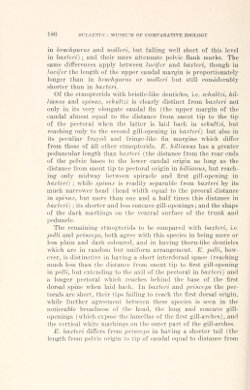 in brachyurus and molleri, but falling well short of this level
in brachyurus and molleri, but falling well short of this level
in baxteri); and their more attenuate pelvic flank marks. The
same differences apply between lucifer and baxteri, though in
lucifer the length of the upper caudal margin is proportionately
longer than in brachyurus or molleri but still considerably
shorter than in baxteri.
Of the etmopterids with bristle-like denticles, i.e. schultzi, hil-
lianus and spinax, schultzi is clearly distinct from baxteri not
only in its very elongate caudal fin (the upper margin of the
caudal almost equal to the distance from snout tip to the tip
of the pectoral when the latter is laid back in schultzi, but
reaching only to the second gill-opening in baxteri) but also in
its peculiar frayed and fringe-like fin margins which differ
from those of all other etmopterids. E. hillianus has a greater
peduncular length than baxteri (the distance from the rear ends
of the pelvic bases to the lower caudal origin as long as the
distance from snout tip to pectoral origin in hillianus, but reach-
ing only midway between spiracle and first gill-opening in
baxteri); while spinax is readily separable from baxteri by its
much narrower head (head width equal to the preoral distance
in spinax, but more than one and a half times this distance in
baxteri); its shorter and less concave gill-openings; and the shape
of the dark markings on the ventral surface of the trunk and
peduncle.
The remaining etmopterids to be compared with baxteri, i.e.
polli and princeps, both agree with this species in being more or
less plain and dark coloured, and in having thorn-like denticles
which are in random but uniform arrangement. E. polli, how-
ever, is distinctive in having a short interdorsal space (reaching
much less than the distance from snout tip to first gill-opening
in polli, but extending to the axil of the pectoral in baxteri) and
a longer pectoral which reaches behind the base of the first
dorsal spine when laid back. In baxteri and princeps the pec-
torals are short, their tips failing to reach the first dorsal origin,
while further agreement between these species is seen in the
noticeable broadness of the head, the long and concave gill-
openings (which expose the lamellae of the first gill-arches), and
the vertical white markings on the outer part of the gill-arches.
E. baxteri differs from princeps in having a shorter tail (the
length from pelvic origin to tip of caudal equal to distance from
page 181 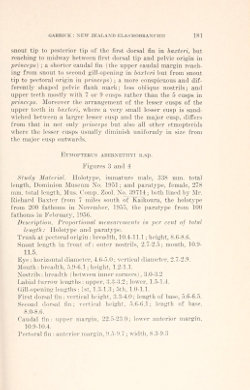 snout tip to posterior tip of the first dorsal fin in baxteri, but
snout tip to posterior tip of the first dorsal fin in baxteri, but
reaching to midway between first dorsal tip and pelvic origin in
princeps); a shorter caudal fin (the upper caudal margin reach-
ing from snout to second gill-opening in baxteri but from snout
tip to pectoral origin in princeps); a more conspicuous and dif-
ferently shaped pelvic flank mark; less oblique nostrils; and
upper teeth mostly with 7 or 9 cusps rather than the 5 cusps in
princeps. Moreover the arrangement of the lesser cusps of the
upper teeth in baxteri, where a very small lesser cusp is sand-
wiched between a larger lesser cusp and the major cusp, differs
from that in not only princeps but also all other etmopterids
where the lesser cusps usually diminish uniformly in size from
the major cusp outwards.
ETMOPTERUS ABERNETHYI n. sp.
Figures 3 and 4
Study Material. Holotype, immature male, 338 mm. total
length, Dominion Museum No. 1951; and paratype, female, 278
mm. total length, Mus. Comp. Zool. No. 39714; both lined by Mr.
Richard Baxter from 7 miles south of Kaikoura, the holotype
from 200 fathoms in November, 1955, the paratype from 100
fathoms in February, 1956.
Description. Proportional measurements in per cent of total
length: Holotype and paratype.
Trunk at pectoral origin: breadth, 10.4-11.1; height, 8.6-8.6.
Snout length in front of: outer nostrils, 2.7-2.5; mouth, 10.9-
11.5.
Eye: horizontal diameter, 4.6-5.0; vertical diameter, 2.7-2.9.
Mouth: breadth, 5.9-6.1; height, 1.2-1.1.
Nostrils: breadth (between inner corners), 3.0-3.2
Labial furrow Lengths: upper, 3.3-3.2; lower, 1.5-1.4.
Gill-opening lengths: 1st, 1.3-1.3; 5th, 1.0-1.1.
First dorsal fin: vertical height, 3.3-4.0; length of base, 5.6-6.5.
Second dorsal fin; vertical height. 5.6-6.1; length of base.
8.0-8.6.
Caudal fin: upper margin, 22.5-23 0; lower anterior margin.
10.9-10.4.
Pectoral fin: anterior margin, 9. 5-!). 7; width, 8.3-9.3
page 182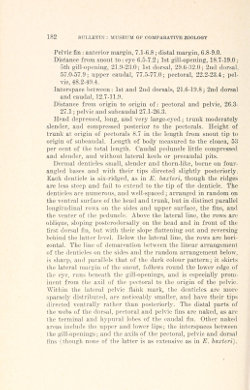 Pelvic fin: anterior margin, 7.1-6.8; distal margin, 6.8-9.0.
Pelvic fin: anterior margin, 7.1-6.8; distal margin, 6.8-9.0.
Distance from snout to: eye 6.5-7.2; 1st gill-opening, 18.7-19.0;
5th gill-opening, 21.9-23.0; 1st dorsal, 29.6-32.0; 2nd dorsal.
57.0-57.9; upper caudal, 77.5-77.0; pectoral, 22.2-23.4; pel-
vic, 48.2-49.4.
Interspace between: 1st and 2nd dorsals, 21.6-19.8; 2nd dorsal
and caudal, 12.7-11.9.
Distance from origin to origin of: pectoral and pelvic, 26.3-
27.1; pelvic and subcaudal 27.1-26.3.
Head depressed, long, and very large-eyed; trunk moderately
slender, and compressed posterior to the pectorals. Height of
trunk at origin of pectorals 8.7 in the length from snout tip to
origin of subcaudal. Length of body measured to the cloaca, 53
per cent of the total length. Caudal peduncle little compressed
and slender, and without lateral keels or precaudal pits.
Dermal denticles small, slender and thorn-like, borne on four-
angled bases and with their tips directed slightly posteriorly.
Each denticle is six-ridged, as in E. baxteri, though the ridges
are less steep and fail to extend to the tip of the denticle. The
denticles are numerous, and well-spaced; arranged in random on
the ventral surface of the head and trunk, but in distinct parallel
longitudinal rows on the sides and upper surface, the fins, and
the venter of the peduncle. Above the lateral line, the rows are
oblique, sloping posterodorsally on the head and in front of the
first dorsal fin, but with their slope flattening out and reversing
behind the latter level. Below the lateral line, the rows are hori-
zontal. The line of demarcation between the linear arrangement
of the denticles on the sides and the random arrangement below,
is sharp, and parallels that of the dark colour pattern; it skirts
the lateral margin of the snout, follows round the lower edge of
the eye, runs beneath the gill-openings, and is especially prom-
inent from the axil of the pectoral to the origin of the pelvic.
Within the lateral pelvic flank mark, the denticles are more
sparsely distributed, are noticeably smaller, and have their tips
directed ventrally rather than posteriorly. The distal parts of
the webs of the dorsal, pectoral and pelvic fins are naked, as are
the terminal and hypural lobes of the caudal fin. Other naked
areas include the upper and lower lips; the interspaces between
the gill-openings; and the axils of the pectoral, pelvic and dorsal
fins (though none of the latter is as extensive as in E. baxteri).
page 183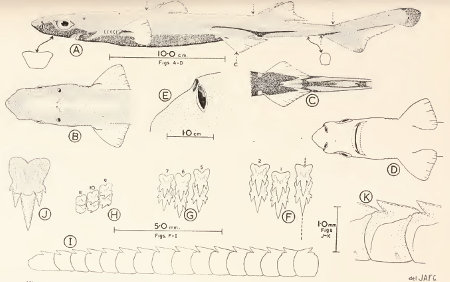
Figure 3. Etmopterus abernethyi n.sp., holotype, 338 mm. total length. A, lateral view and insets of sec-
tions through snout and peduncle; B, dorsal view of head showing pale regions; C, ventral view of
peduncle; D, ventral view of head; E, left nostril; F-K, paratype, 278 mm. total length; F-H, upper teeth
from right side, row numbers indicated above; I, lower teeth from right side; J, 3rd upper tooth, right side;
K, 4th lower tooth, right side. 8c = level of cloaca.)
page 184 Head measured to first gill-opening 5.3 in the total length, and
Head measured to first gill-opening 5.3 in the total length, and
about two-thirds of the distance from snout tip to first dorsal
origin. Head long, flat above, and with little change in width
from the level of the spiracles to the level of the nostrils. Inter-
orbital width 1.4 in the preoral distance. The snout contours
rapidly taper at the level of the nostrils so that the snout tip is
prominently pointed. In lateral view the snout is of almost equal
thickness from the hind level of the eyes to the nostrils, though
anterior to the latter the profile angles steepen to form the
bluntly wedge-shaped snout tip. Length of snout, measured to
eye, 2.9 in the head. Eye large, ovoid, nearly twice as long as
high; its horizontal diameter 1.4 in the snout. Spiracle large, its
length just less than one quarter of the horizontal diameter of the
eye, and placed just above the eye and behind it by a distance
equal to one and a half times its own length. Gill-openings small,
each vertical but concave, their lengths subequal and about 4.0
in the eye. Interspaces between the gill-openings decrease slightly
posteriorly. Nostrils large, oblique, and well anterior on the
venter of the snout. Each nasal aperture subdivided by tri-
angular nasal flaps into a circular, anterolateral aperture facing
to the anterior, and an ovoid posteromedial aperture which is
margined in front and behind by a low membrane. The anterior
nasal flap is attenuate, sharply pointed, and external to the short
fleshy posterior flap. Mouth broad and little arched, its width
1.5 in the preoral distance, the latter 1.7 in the head. The upper
labial furrows deeply incised anteriorly, their length equal to the
distance from their anterior extremities to the symphysis of the
upper jaw, and arranged so that one-third is anterior to the
angle of the jaw and two-thirds is posterior. The lower labial
furrows are shallowly incised and short, their length less than
half that of the upper furrows.
Teeth 11-1-11/18-17 in the male of 338 mm., 10-1-11/16-15 in the female of
278 mm., dissimilar in the two jaws. The upper teeth erect, multi-
cusped, each with a long, sharply-pointed, awl-shaped, smooth-
edged major cusp flanked on each side by one or two lesser cusps,
and borne on a longitudinally-striated base. Most of the upper
teeth have two lesser cusps on each side of the major cusp, with
the outer cusp of these two very much smaller than the inner
which is one-third to one-half of the length of the major cusp.
page 185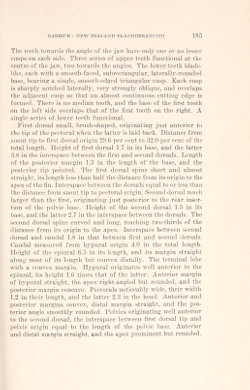 The teeth towards the angle of the jaw have only one or no lesser
The teeth towards the angle of the jaw have only one or no lesser
cusps on each side. Three series of upper teeth functional at the
centre of the jaw, two towards the angles. The lower teeth blade-
like, each with a smooth-faced, subrectangular, laterally-rounded
base, bearing a single, smooth-edged triangular cusp. Each cusp
is sharply notched laterally, very strongly oblique, and overlaps
the adjacent cusp so that an almost continuous cutting edge is
formed. There is no median tooth, and the base of the first tooth
on the left side overlaps that of the first tooth on the right. A
single series of lower teeth functional.
First dorsal small, brush-shaped, originating just anterior to
the tip of the pectoral when the latter is laid back. Distance from
snout tip to first dorsal origin 29.6 per cent to 32.0 per cent of the
total length. Height of first dorsal 1.7 in its base, and the latter
3.8 in the interspace between the first and second dorsals. Length
of the posterior margin 1.3 in the length of the base, and the
posterior tip pointed. The first dorsal spine short and almost
straight, its length less than half the distance from its origin to the
apex of the fin. Interspace between the dorsals equal to or less than
the distance from snout tip to pectoral origin. Second dorsal much
larger than the first, originating just posterior to the rear inser-
tion of the pelvic base. Height of the second dorsal 1.5 in its
base, and the latter 2.7 in the interspace between the dorsals. The
second dorsal spine curved and long, reaching two-thirds of the
distance from its origin to the apex. Interspace between second
dorsal and caudal 1.8 in that between first and second dorsals.
Caudal measured from hypural origin 4.0 in the total length.
Height of the epiural 6.5 in its length, and its margin straight
along most of its length but convex distally. The terminal lobe
with a convex margin. Hypural originates well anterior to the
epiural, its height 1.6 times that of the latter. Anterior margin
of hypural straight, the apex right-angled but rounded, and the
posterior margin concave. Pectorals noticeably wide, their width
1.2 in their length, and the latter 2.3 in the head. Anterior and
posterior margins convex, distal margin straight, and the pos-
terior angle smoothly rounded. Pelvics originating well anterior
to the second dorsal, the interspace between first dorsal tip and
pelvic origin equal to the length of the pelvic base. Anterior
and distal margin straight, and the apex prominent but rounded.
page 186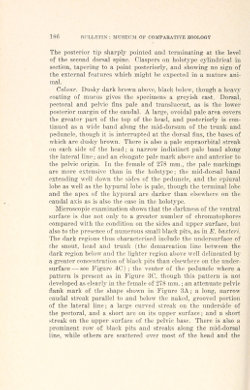 The posterior tip sharply pointed and terminating at the level
The posterior tip sharply pointed and terminating at the level
of the second dorsal spine. Claspers on holotype cylindrical in
section, tapering to a point posteriorly, and showing no sign of
the external features which might be expected in a mature ani-
mal.
Colour. Dusky dark brown above, black below, though a heavy
coating of mucus gives the specimens a greyish cast. Dorsal,
pectoral and pelvic fins pale and translucent, as is the lower
posterior margin of the caudal. A large, ovoidal pale area covers
the greater part of the top of the head, and posteriorly is con-
tinued as a wide band along the mid-dorsum of the trunk and
peduncle, though it is interrupted at the dorsal fins, the bases of
which are dusky brown. There is also a pale supraorbital streak
on each side of the head; a narrow indistinct pale band along
the lateral line; and an elongate pale mark above and anterior to
the pelvic origin. In the female of 278 mm., the pale markings
are more extensive than in the holotype; the mid-dorsal band
extending well down the sides of the peduncle, and the epiural
lobe as well as the hypural lobe is pale, though the terminal lobe
and the apex of the hypural are darker than elsewhere on the
caudal axis as is also the case in the holotype.
Microscopic examination shows that the darkness of the ventral
surface is due not only to a greater number of chromatophores
compared with the condition on the sides and upper surface, but
also to the presence of numerous small black pits, as in E. baxteri.
The dark regions thus characterised include the undersurface of
the snout, head and trunk (the demarcation line between the
dark region below and the lighter region above well delineated by
a greater concentration of black pits than elsewhere on the under-
surface - see Figure 4C); the venter of the peduncle where a
pattern is present as in Figure 3C, though this pattern is not
developed as clearly in the female of 278 mm.; an attenuate pelvic
flank mark of the shape shown in Figure 3A; a long, narrow
caudal streak parallel to and below the naked, grooved portion
of the lateral line; a large curved streak on the underside of
the pectoral, and a short arc on its upper surface; and a short
streak on the upper surface of the pelvic base. There is also a
prominent row of black pits and streaks along the mid-dorsal
line, while others are scattered over most of the head and the
page 187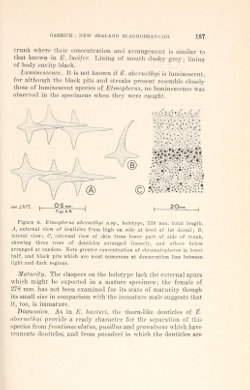 trunk where their concentration and arrangement is similar to
trunk where their concentration and arrangement is similar to
that known in E. lucifer. Lining of mouth dusky grey; lining
of body cavity black.
Luminescence. It is not known if E. abernethyi is luminescent,
for although the black pits and streaks present resemble closely
those of luminescent species of Etmopterus, no luminescence was
observed in the specimens when they were caught.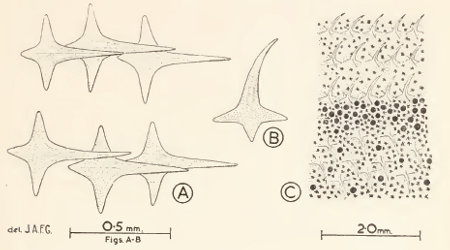
Figure 4. Etmopterus abernethyi n.sp., holotype, 338 mm. total length.
A, external view of denticles from high on side at level of 1st dorsal; B,
lateral view; C, external view of skin from lower part of side of trunk,
showing three rows of denticles arranged linearly, and others below
arranged at random. Note greater concentration of chromatophores in lower
half, and black pits which are most numerous at demarcation line between
light and dark regions.
Maturity. The claspers on the holotype lack the external spurs
which might be expected in a mature specimen; the female of
278 mm. has not been examined for its state of maturity though
its small size in comparison with the immature male suggests that
it, too, is immature.
Discussion. As in E. baxteri, the thorn-like denticles of E.
abernethyi provide a ready character for the separation of this
species from frontimaculatus, pusillus and granulosus which have
truncate denticles, and from paessleri in which the denticles are
page 188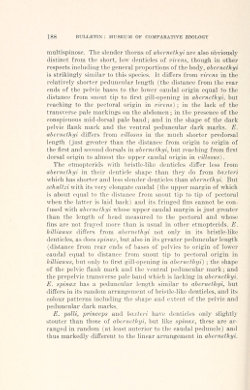 multispinose. The slender thorns of abernethyi are also obviously
multispinose. The slender thorns of abernethyi are also obviously
distinct from the short, low denticles of virens, though in other
respects including the general proportions of the body, abernethyi
is strikingly similar to this species. It differs from virens in the
relatively shorter peduncular length (the distance from the rear
ends of the pelvic bases to the lower caudal origin equal to the
distance from snout tip to first gill-opening in abernethyi, but
reaching to the pectoral origin in virens); in the lack of the
transverse pale markings on the abdomen; in the presence of the
conspicuous mid-dorsal pale band; and in the shape of the dark
pelvic flank mark and the ventral peduncular dark marks. E.
abernethyi differs from villosus in the much shorter predorsal
length (just greater than the distance from origin to origin of
the first and second dorsals in abernethyi, but reaching from first
dorsal origin to almost the upper caudal origin in villosus).
The etmopterids with bristle-like denticles differ less from
abernethyi in their denticle shape than they do from baxteri
which has shorter and less slender denticles than abernethyi. But
schultzi with its very elongate caudal (the upper margin of which
is about equal to the distance from snout tip to tip of pectoral
when the latter is laid back) and its fringed fins cannot be con-
fused with abernethyi whose upper caudal margin is just greater
than the length of head measured to the pectoral and whose
fins are not frayed more than is usual in other etmopterids. E.
hillianus differs from abernethyi not only in its bristle-like
denticles, as does spinax, but also in its greater peduncular length
(distance from rear ends of bases of pelvics to origin of lower
caudal equal to distance from snout tip to pectoral origin in
hillianus, but only to first gill-opening in abernethyi); the shape
of the pelvic flank mark and the ventral peduncular mark; and
the prepelvic transverse pale band which is lacking in abernethyi.
E. spinax has a peduncular length similar to abernethyi, but
differs in its random arrangement of bristle-like denticles, and its
colour patterns including the shape and extent of the pelvic and
peduncular dark marks.
E. polli, princeps and baxteri have denticles only slightly
stouter than those of abernethyi, but like spinax, these are ar-
ranged in random (at least anterior to the caudal peduncle) and
thus markedly different to the linear arrangement in abernethyi.
page 189 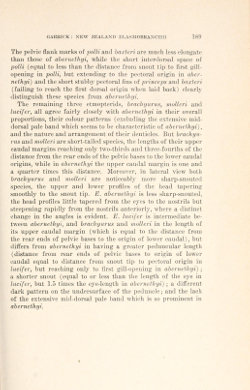 The pelvic flank marks of polli and baxteri are much less elongate
The pelvic flank marks of polli and baxteri are much less elongate
than those of abernethyi, while the short interdorsal space of
polli (equal to less than the distance from snout tip to first gill-
opening in polli, but extending to the pectoral origin in aber-
nethyi) and the short stubby pectoral fins of princeps and baxteri
(failing to reach the first dorsal origin when laid back) clearly
distinguish these species from abernethyi.
The remaining three etmopterids, brachyurus, molleri and
lucifer, all agree fairly closely with abernethyi in their overall
proportions, their colour patterns (excluding the extensive mid-
dorsal pale band which seems to be characteristic of abernethyi),
and the nature and arrangement of their denticles. Bat brachyu-
rus and molleri are short-tailed species, the lengths of their upper
caudal margins reaching only two-thirds and three-fourths of the
distance from the rear ends of the pelvic bases to the lower caudal
origins, while in abernethyi the upper caudal margin is one and
a quarter times this distance. Moreover, in lateral view both
brachyurus and molleri are noticeably more sharp-snouted
species, the upper and lower profiles of the head tapering
smoothly to the snout tip. E. abernethyi is less sharp-snouted,
the head profiles little tapered from the eyes to the nostrils but
steepening rapidly from the nostrils anteriorly, where a distinct
change in the angles is evident. E. lucifer is intermediate be-
tween abernethyi, and brachyurus and molleri in the length of
its upper caudal margin (which is equal to the distance from
the rear ends of pelvic bases to the origin of lower caudal), but
differs from abernethyi in having a greater peduncular length
(distance from rear ends of pelvic bases to origin of lower
caudal equal to distance from snout tip to pectoral origin in
lucifer, but reaching only to first gill-opening in abernethyi);
a shorter snout (equal to or less than the length of the eye in
lucifer, but 1.5 times the eye-length in abernethyi); a different
dark pattern on the undersurface of the peduncle; and the lack
of the extensive mid-dorsal pale band which is so prominent in
abernethyi.
page 190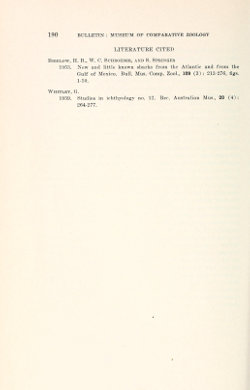 LITERATURE CITED
LITERATURE CITED
BlGELOW, H. B., W. C. SCHROEDER, AND S. SPRINGER
1953. New and little known sharks from the Atlantic and from the
Gulf of Mexico. Bull. Mus. Comp. Zool., 109 (3): 213-276, figs.
1-10.
WHITLEY, G.
1939. Studies in ichthyology no. 12. Bee. Australian Mus., 20 (4):
264-277.


-

- Bibliography
- All
- Recent
- Fossil
- First descriptions
-

-

-

- Typecatalog
- Map of types
- Database
-

- Parasites
- Host-Parasites List
- Parasite-Hosts List









